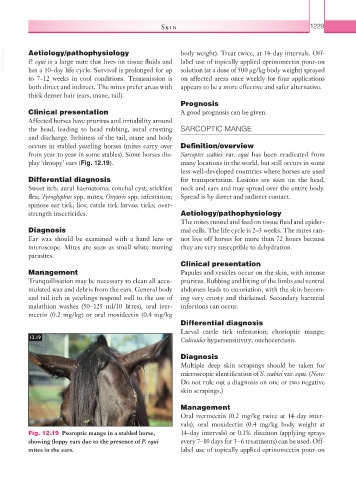Page 1254 - Equine Clinical Medicine, Surgery and Reproduction, 2nd Edition
P. 1254
Skin 1229
VetBooks.ir Aetiology/pathophysiology body weight). Treat twice, at 14-day intervals. Off-
label use of topically applied eprinomectin pour-on
P. equi is a large mite that lives on tissue fluids and
has a 10-day life cycle. Survival is prolonged for up
to 7–12 weeks in cool conditions. Transmission is solution (at a dose of 500 μg/kg body weight) sprayed
on affected areas once weekly for four applications
both direct and indirect. The mites prefer areas with appears to be a more effective and safer alternative.
thick denser hair (ears, mane, tail).
Prognosis
Clinical presentation A good prognosis can be given.
Affected horses have pruritus and irritability around
the head, leading to head rubbing, aural crusting SARCOPTIC MANGE
and discharge. Itchiness of the tail, mane and body
occurs in stabled yearling horses (mites carry over Definition/overview
from year to year in some stables). Some horses dis- Sarcoptes scabiei var. equi has been eradicated from
play ‘droopy’ ears (Fig. 12.19). many locations in the world, but still occurs in some
less well-developed countries where horses are used
Differential diagnosis for transportation. Lesions are seen on the head,
Sweet itch; aural haematoma; conchal cyst; stickfast neck and ears and may spread over the entire body.
flea; Tyroglyphus spp. mites; Oxyuris spp. infestation; Spread is by direct and indirect contact.
spinose ear tick; lice; cattle tick larvae; ticks; over-
strength insecticides. Aetiology/pathophysiology
The mites tunnel and feed on tissue fluid and epider-
Diagnosis mal cells. The life cycle is 2–3 weeks. The mites can-
Ear wax should be examined with a hand lens or not live off horses for more than 72 hours because
microscope. Mites are seen as small white moving they are very susceptible to dehydration.
parasites.
Clinical presentation
Management Papules and vesicles occur on the skin, with intense
Tranquillisation may be necessary to clean all accu- pruritus. Rubbing and biting of the limbs and ventral
mulated wax and debris from the ears. General body abdomen leads to excoriation, with the skin becom-
and tail itch in yearlings respond well to the use of ing very crusty and thickened. Secondary bacterial
malathion washes (50–125 ml/10 litres), oral iver- infections can occur.
mectin (0.2 mg/kg) or oral moxidectin (0.4 mg/kg
Differential diagnosis
Larval cattle tick infestation; chorioptic mange;
12.19 Culicoides hypersensitivity; onchocerciasis.
Diagnosis
Multiple deep skin scrapings should be taken for
microscopic identification of S. scabiei var. equi. (Note:
Do not rule out a diagnosis on one or two negative
skin scrapings.)
Management
Oral ivermectin (0.2 mg/kg twice at 14-day inter-
vals), oral moxidectin (0.4 mg/kg body weight at
Fig. 12.19 Psoroptic mange in a stabled horse, 14-day intervals) or 0.1% diazinon (applying sprays
showing floppy ears due to the presence of P. equi every 7–10 days for 3–6 treatments) can be used. Off-
mites in the ears. label use of topically applied eprinomectin pour-on

